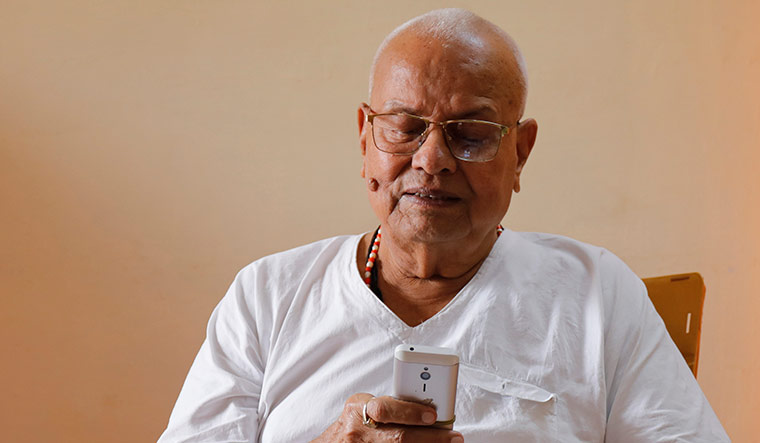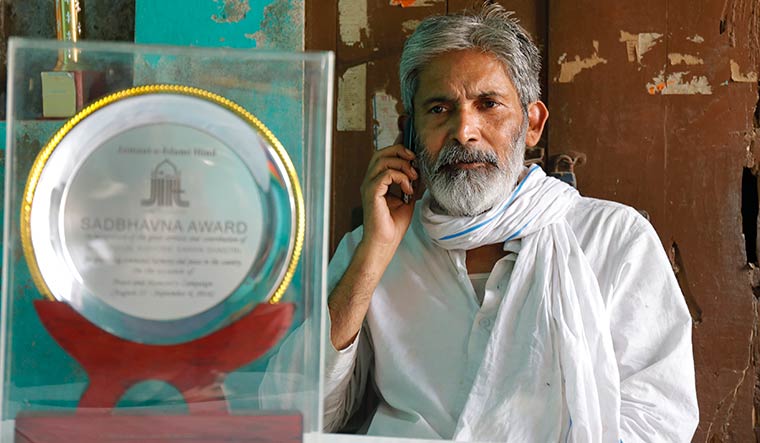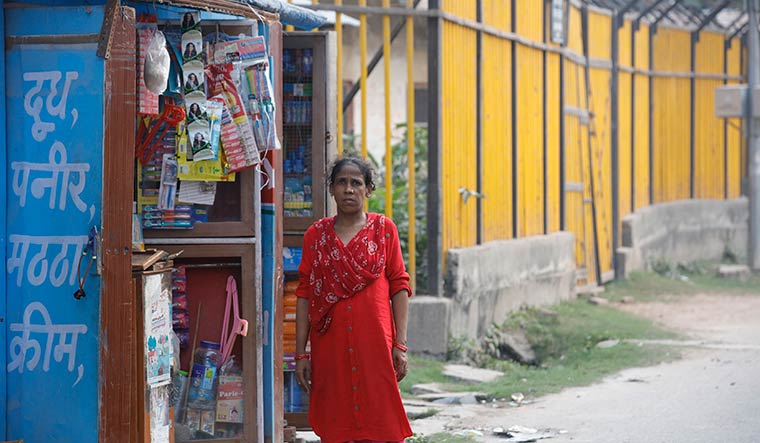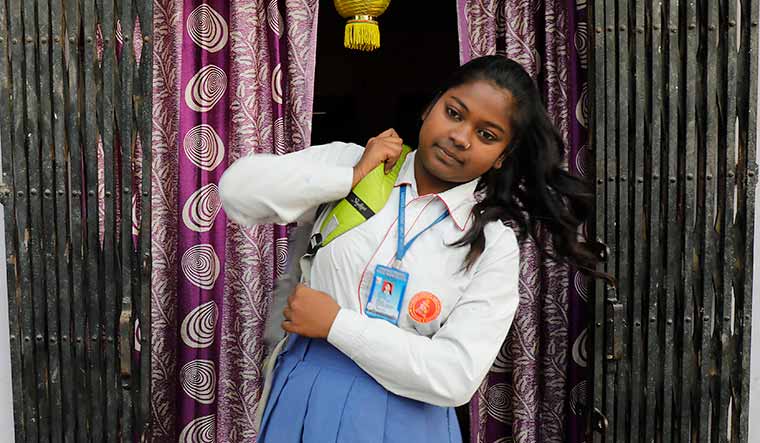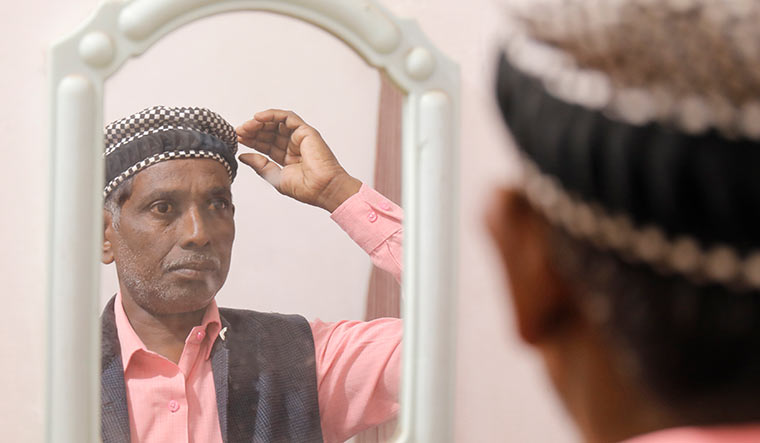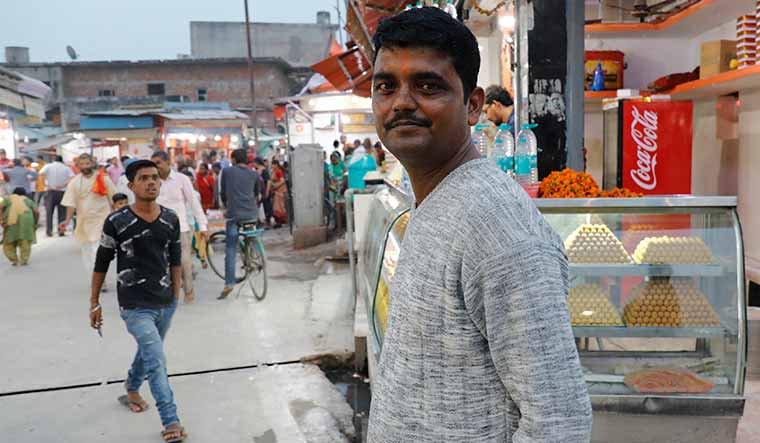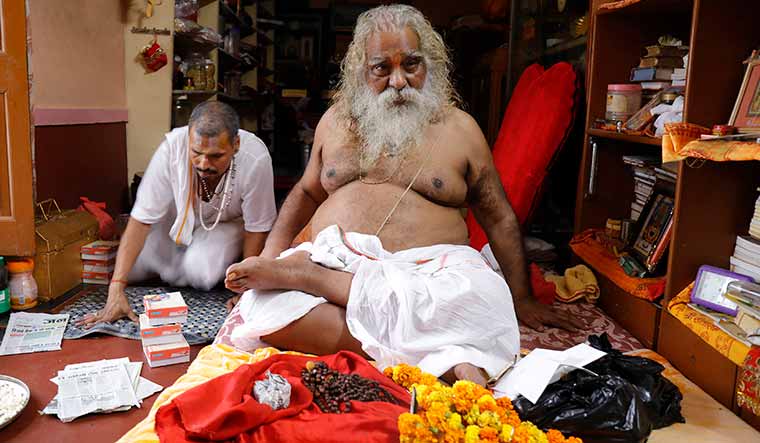SUBHASH PANDEY, 40
manages a book stall at the Ram Janmabhumi Nyas workshop
I have very few memories of my father, who was killed in the [1990] firing, but I do remember that gloom hung over our house for two years. My father was the only son. The only thought my grandmother clung to was that his martyrdom was not for just any temple, but for the Ram Janmabhumi. The Vishva Hindu Parishad (VHP) helped educate me till class 12 and then gave me a job at the book stall. They also helped in the marriage of my two younger sisters. Leaving Ayodhya was never an option. This job is my way of contributing to the mandir movement. The book I sell most tells of the blood-soaked history of the movement.
PURSHOTTAM NARAYAN SINGH, 84
Sangh pracharak and patron of the VHP
When the lock to the site was opened in 1984, we thought the end of the dispute was near. But the court processes took long. I was responsible for the Sangh’s special communication initiatives. My responsibilities also included logistics, planning, supervision and management of money for all programmes here. In 1990, there were 1.5 lakh kar sevaks in Ayodhya. Ten messes were operational. Whoever chanted “Jai Shri Ram” was deemed to be a kar sevak and would be provided lodging and food. It was a very busy time. Sometimes, Singhalji (Ashok Singhal, former VHP president) would make grand announcements and we would have no clue how they would be carried out. But he would always say, “It will all be done, do not worry.” I was confident that the judgment would be in our favour. A Ram temple did exist. There is no way to dispute that. The Muslims know the truth.
YUGAL KISHORE SHARAN SHASTRI, 62
social activist
On December 6, 1992, a number of social activists including Nirmala Deshpande were at my home, which was just 200 steps away from Babri Masjid. We had vowed to give up our lives in defence of the mosque. But there was a storm of people that day. I saw four Muslims being set on fire by kar sevaks. That left me horrified for years. I begged the police to rescue them. But they had also turned into kar sevaks. A journalist whose clothes were torn sought refuge in my house. I gave her a dhoti to wear and helped her escape. I saw political leaders at the site. I heard the chant “Ek dhakka aur do” (one more push). More than 10 Muslim households in the area were set on fire. Yet the Muslims never went to court to testify. They are still scared. The court decides based on public sentiment. I am not interested in the verdict.
GUDIYA, 45
shopkeeper
I remember every detail of what happened on December 6, 1992. We live close to the Babri Masjid, and clearly heard all the commotion. We heard them shout, “Lala tailor ko utha lao” (Get Lala tailor—her father Waliullah). We locked our home and crouched inside. At least a dozen men scaled the walls of our home and set our straw roof on fire. A Hindu doctor ushered us to safety. We left Ayodhya empty-handed. When we returned three weeks later, our home was charred. My father’s eight sewing machines were burnt. I had to clean the walls repeatedly, and then painted them on my own. My elder sister was to get married, but it took a year to get it done. I was in class eight, but never went back to school. I was good at mathematics. I wanted to become a police constable. The Hindus of Ayodhya did not touch us. It was those who came from outside, with blood in their eyes. So much bloodshed in the name of God cannot be justified.
TANYA RAO, 16
student
I have heard about the Ayodhya title case from the news and my elders, but generally there is not much talk of it at home. I have Muslim friends. We visit each other’s homes, but this topic never comes up. They might be uncomfortable. Everyone wants to avoid talking about it. In a way, we have paid for something that we had no role in. The incident stalled all development in Ayodhya. Being a religious centre is fine, but outside that core area, there should be clubs and malls. But this city is frozen in time. There are limited opportunities for higher education. I want to be an archaeologist, but for that, I will have to go elsewhere. If there are good educational facilities here, people’s minds will be broadened. They will look beyond religion. People should understand humanity comes first. Religion is secondary. So many innocent people died because of a place of worship. So much time was lost waiting for a verdict. How does any of that make sense? It was all so useless.
IQBAL ANSARI, 53
son of Hashim Ansari, the original litigant in the title suit
The matter of this suit went out of the hands of the original litigants many years ago. We have been helpless bystanders. Councils and committees took over. Maybe my father was used. But, whatever the decision is, it is acceptable to me. My father died waiting for a decision. He left with a heart filled with regret. For me, this is the fulfilment of my duty as his son. My father was good friends with the seers. I have many Hindu friends. We meet and eat at other’s homes, but no one talks about this. Whatever has to be said is said only in court. Ayodhya has a history of communal harmony. No one in Ayodhya caused any violence. It was all the work of outsiders.
SAMEER PATHAK, 30
tourist guide
I have been a guide for five years. This is not a tourist destination, but a religious one. So all we help the visitors with is a darshan. Before building a mandir, why not pay attention to developing Ayodhya as a tourist destination? We tell visitors that there are eight must-visit places in Ayodhya, but most people only want to see the disputed site. They want to leave before dark. There are no places to stay and this keeps people away. Politics has kept Ayodhya backward. If Ayodhya were developed, how would politicians do their politics here? The government must first restore the grandeur of Ayodhya. People are critical of the Yogi government’s decision to light five and a half lakh lamps on the banks of the Sarayu, but I have seen the banks dirty and pitch dark on Diwali. When these images are broadcast around the world, people will see Ayodhya in new light.
SANDEEP KUMAR GUPTA, 30
cloth shop owner
My father, Basudev Gupta, was about 40 years old when he died in the firing. He decided that he would also be part of the kar seva. He made halwa that morning and distributed it to our neighbours. First, they went for a parikrama (circumambulation), but the police stopped them. Then my father led a group to the Ram Janmabhumi. On the way back, the police surrounded them. My mother would say that at that moment a helicopter hovered over Ayodhya. Mulayam Singh Yadav was in that helicopter. It had a green light on. Then the light turned red and there was sound of firing. My father was a rebel and a social worker. He stood by the people. I still do not understand why he had to die. There was no talk of demolishing the mosque. My father would never have participated in anything that would have harmed others. His death changed everything. There were long years when we had to forgo basic necessities. My father was a martyr for the cause of the temple. It is necessary that a grand temple be made in Ayodhya. That is the only way my father’s memory will be honoured. I do not think Muslims suffered in any way. They were not responsible for any violence. The government of the day created mischief. The restrictions made people very angry. The firing made things worse.
BHANU PRAKASH DAHIYA, 48
manager, Sri Ayodhya Ratnapuri Jain Shwetambar Teerth Trust
This is the second most important Jain Shwetambar temple in the country. It is more than 200 years old. We get bus loads of devotees from Maharashtra and Gujarat. We are very happy with the decision. Fear has kept people from coming to Ayodhya. Once the Ram mandir is constructed, business will boom. Jain devotees visit the Ram Janmabhumi also. I have never heard of any kind of trouble between the different communities here. The land belongs to Lord Ram. A mosque can be built anywhere. We do not criticise either Hindus or Muslims, but heritage and history must be respected. There are Muslims around here who want a temple to be constructed. The country needs people like Modiji who can take tough decisions. If the temple is not made now, it will never be made.
NRITYA GOPAL DAS, 81
president, Ram Janmabhumi Nyas
The wait for the verdict had been beautiful. There was never a moment of hopelessness. A grand temple will come up where Ram Lalla lives now. It does not matter whether it takes 10 or 20 years. The Ayodhya of 1990 is no different from the Ayodhya of today. It keeps its character, no matter how the world around it changes. The death of the kar sevaks was a product of those times. The structure had fallen. Such things happen. It is the death of the kar sevaks which will ensure that the temple is constructed. I do not remember much about how they died. I know for sure that the mandir will be constructed during Modiji and Yogiji’s term. How do I say if they are above the Supreme Court? God is above all. God’s devotees are above him.



